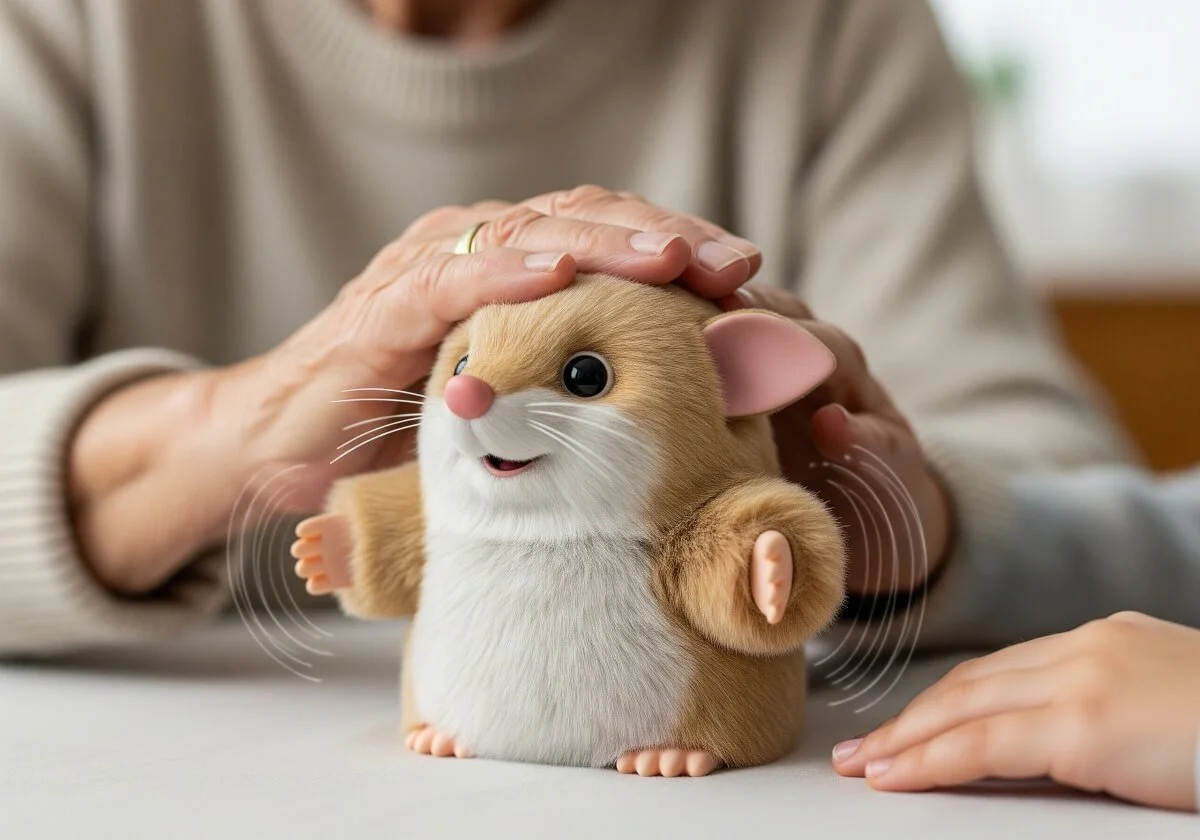Beyond the Hype: How a $400 Robot Pet Reveals the True Future of Accessible AI Technology
While global headlines fixate on multi-billion dollar enterprise AI deals, the most profound revolutions often begin quietly, not in a boardroom, but in a living room. The sensational sell-out success of Moflin, a ¥59,400 (approx. $400) AI-powered robot pet, is a critical signal of a far more significant trend: the rise of truly Accessible AI Technology. This movement is the cornerstone of modern Japanese Consumer Tech, demonstrating a path for the seamless Integration of artificial intelligence into the very fabric of our lives. Unlike monolithic corporate systems, these advancements move technology from the exclusive domain of specialists into the hands of everyday people. This democratization is not merely a social benefit; it represents the sustainable, market-building innovation that defines the future.
The Power of “Low-Touch” Integration
Making Advanced AI Feel Effortless
For any new technology to achieve mass adoption, it must first overcome the formidable barriers of complexity, cost, and intimidation. This is precisely where products like Moflin excel. They are "low-touch" in the most meaningful sense. There is no complex coding to learn, no intimidating interface to navigate, and no dense user manual to decipher. You simply interact with it. You pet it, you hold it, and through these simple, intuitive actions, you engage with a sophisticated artificial intelligence that learns, adapts, and develops a unique personality based on your specific interactions.
This represents a monumental shift in our relationship with machines. For decades, the burden was on humans to learn the language of computers. We learned to type on keyboards, master complex operating systems, and structure our thoughts to appease search engine algorithms. In contrast, Accessible AI Technology inverts this entire dynamic. Now, the machine is finally learning our language—the deeply human language of touch, emotion, and non-verbal cues.
This process of effortless Integration is absolutely critical for the future. When technology becomes this intuitive, it stops being a "tool" we consciously decide to "use" and instead becomes a natural, supportive part of our environment. For a child, Moflin isn't a complex network of sensors and algorithms; it's simply a fluffy, warm companion. For an elderly person living alone, it provides comfort and a source of interaction, not a piece of intimidating hardware. This is the ultimate goal of user experience design: to make technology so seamless that it disappears into the background of our lives, enhancing them without demanding specialized skills. This philosophy is a hallmark of the most successful Japanese Consumer Tech, from the Walkman to the Nintendo Switch, where immense complexity is masterfully hidden behind a simple, joyful interface.
Why Public Markets Should Champion Consumer AI
Building Sustainable and Scalable Growth
The narrative in public investment circles often lionizes massive, top-down enterprise solutions. While these systems are undoubtedly important, they represent only one-half of a healthy technology ecosystem. A truly mature market requires both a strong enterprise sector and a vibrant, innovative consumer sector. Consequently, the success of products like Moflin is a profoundly bullish indicator for several key reasons.
This image captures the universal appeal of accessible AI technology. The shared interaction between young and old demonstrates the successful integration of Japanese consumer tech into the family, providing joy and a common interest across generations.
Massive Market Validation
Enterprise AI serves a finite number of corporations. In contrast, consumer AI serves a potential market of billions of individuals. The Total Addressable Market (TAM) for Accessible AI Technology is therefore orders of magnitude larger. The immediate sell-out success of a $400 AI pet demonstrates a clear and powerful consumer appetite for emotionally resonant technology. It proves that people are willing to pay for AI that delivers joy and companionship, not just productivity. This is a foundational insight that companies like those featured on akiyaz.io, a platform for Japanese real estate, understand well: the home is the center of consumer life.
Building a Foundation for Future Services
Moflin is far more than a standalone product; it is a platform. The creation of a "Moflin Membership Club," which offers an annual fee for maintenance, fur replacements, and data revival, is a brilliant strategy for building a recurring revenue stream. This model, often called Hardware-as-a-Service (HaaS), is incredibly attractive to investors because it fosters a long-term relationship with the customer. Furthermore, it opens the door for a vast array of future services. Imagine a future where the Moflin platform offers educational modules for children, advanced companionship features for seniors, or even full Integration with smart home ecosystems.
De-Risking Wide-Spread AI Adoption
Every person who buys and loves a Moflin is being gently onboarded into the AI era. They are becoming comfortable with the idea of machines that learn, adapt, and hold an emotional place in their lives. This broad-based cultural acceptance is invaluable. It de-risks future, more advanced AI applications by creating a populace that is curious and accepting, rather than fearful and resistant. A society that embraces AI pets today is far more likely to welcome AI-assisted healthcare, personalized education, and autonomous transportation tomorrow. You can learn more about us and our perspective on this technological shift at the I Can Japan AI about page.
The Japanese Context: A Perfect Ecosystem for Integration
Where Culture and Demographics Drive Innovation
It is no coincidence that Moflin is finding its initial, explosive success in Japan. The nation provides a perfect cultural and demographic ecosystem for this type of technology to flourish, making it a critical testbed for the rest of the world. The creative spirit behind such innovations is nurtured in dynamic environments like those fostered by production houses such as Lel Studios.
A Culture of Anthropomorphism: From ancient folklore populated by yōkai (spirits) to the modern global dominance of characters like Pikachu, Japanese culture has a long and celebrated history of imbuing objects with personality and soul. The concept of a robot companion is not a strange, futuristic idea; it is the modern incarnation of a deeply ingrained cultural tradition. This history makes the Integration of a product like Moflin feel entirely natural and welcome, rather than alien.
Powerful Demographic Drivers: Japan is at the forefront of a global demographic shift, with one of the world's most rapidly aging populations and a consistently low birthrate. According to Japan's Ministry of Internal Affairs and Communications, as of 2024, an estimated 29.1% of the population is 65 or older. This creates a genuine and urgent social need for technologies that can provide companionship, monitor well-being, and alleviate loneliness. While Moflin is presented as a pet, its underlying technology can easily be adapted into therapeutic tools for the elderly, providing comfort and a sense of connection. The success of this Japanese Consumer Tech serves as a vital blueprint for solutions that will soon be desperately needed worldwide.
Unmatched Technological Sophistication: Japanese consumers are famously discerning. They appreciate quality craftsmanship, innovative design, and true technological sophistication. A product that succeeds in this demanding market has proven its excellence on a global scale. Casio, a legacy electronics giant, understands this landscape perfectly. Their ability to pivot and innovate in the AI space with a product of this quality signals the continued vitality and adaptability of Japan's established tech industry.
The excitement at a retail display for M-oflin illustrates the strong market demand for Japanese consumer tech. This level of public interest is a clear indicator of the successful integration of accessible AI technology into the mainstream marketplace.
The Global Implications of Accessible AI
The rise of Accessible AI Technology is not about replacing human connection but augmenting it. It is about filling the small gaps in our modern lives with moments of joy, comfort, and meaningful engagement. Moflin is not a replacement for the family dog; it is a companion for the person in a small Tokyo apartment where a dog isn't feasible. It is for the child learning about responsibility, the student de-stressing during exams, or the grandparent who enjoys the simple pleasure of caring for something that responds to their touch.
This is the true, democratized promise of artificial intelligence. It promises a world not run by cold, calculating machines, but one enriched by technology that is warm, personal, and profoundly human-centric. While the titans of tech battle for enterprise supremacy, a quiet revolution is happening in living rooms across Japan and, soon, the world. For those with the wisdom to see it, this is where the real future is being built, one friendly, fluffy robot at a time. The journey of Japanese Consumer Tech is a story all of us at I Can Japan are watching closely.
What is Your Vision for Personal AI?
The era of personal, accessible AI is just beginning. From companion robots to intelligent home assistants, this technology will reshape our daily lives. What role do you see AI playing in your home? Share your thoughts and join the conversation about Japan's technological future.


